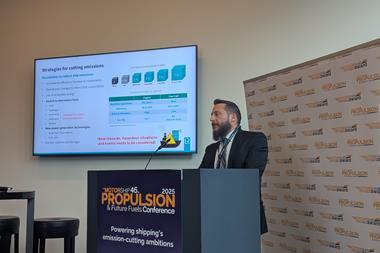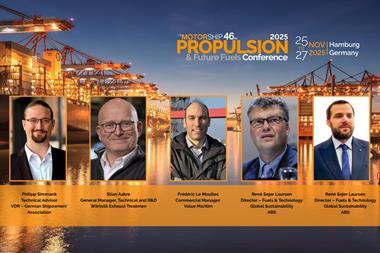The discussion around ammonia as a marine fuel was marked by equal parts ambition and honesty.

Again at the first day of the Propulsion and Future Fuels event gathering in Hamburg, the discussion around ammonia as a marine fuel was marked by equal parts ambition and honesty. Dr Andreas Schmid of WinGD and Andreas Humbucker of TGE Marine Gas Engineering outlined both the promise and the very real limitations of adopting ammonia at scale, offering a grounded picture of where the industry stands after several years of intensive research, development and early pilot projects.
Dr Schmid began by recalling how little practical knowledge existed when WinGD launched its ammonia engine programme. The theoretical risks were well known – burn ammonia under the wrong conditions and you can create more greenhouse gases than diesel – but almost no contemporary combustion data existed. As he noted wryly, “nobody was that foolish” to burn ammonia in a modern engine, which meant every tool, model and facility had to be created from scratch. WinGD therefore began by mobilising universities and research institutes to run fundamental combustion tests and generate the data needed to develop simulation tools.
The breakthrough came quickly: only six weeks after starting, WinGD achieved its first ammonia combustion in its constant-volume spray chamber, allowing engineers to observe flame behaviour, emissions and stability without consuming fuel or risking large-scale failure. From there, the company built hardware test facilities, including injection rigs designed to fail so weak points could be identified early. Alongside engineering, a parallel effort was needed in safety and people management. WinGD trained its workforce to handle ammonia responsibly, working closely with local authorities and fire services to understand the implications of storing thousands of litres of toxic, corrosive fuel on site.
One of the biggest departures from diesel norms concerned fuel circulation. Unlike conventional fuels, ammonia cannot remain inside a stopped engine, so WinGD had to design a system capable of returning unused fuel back to a catch tank using nitrogen to push it through. They also developed a water-flush procedure, exploiting ammonia’s high solubility in water to remove residual traces from the system before maintenance. These process-engineering tasks were well outside traditional engine-builder expertise, forcing WinGD to collaborate with chemical engineers and other specialists.
The result of this effort has been the first fully validated ammonia two-stroke engine. Single-cylinder tests showed efficiencies comparable to – or slightly better than – diesel, stable combustion across the whole load range and over 90% greenhouse gas reduction on a tank-to-wake basis. The feared formation of nitrous oxide turned out to be minimal, with the bulk of remaining emissions originating from the small amount of pilot fuel still required. Engine-out ammonia slip was kept below 10 ppm and NOx emissions were around 40% lower than an equivalent diesel engine. These results have now been reproduced on full-scale customer engines, and WinGD has opened an orderbook covering four engine sizes from roughly 5 MW up to 50 MW.
If WinGD’s work demonstrates that ammonia engines can be made to run safely and efficiently, TGE Marine’s perspective focuses on what is required to integrate ammonia into ships and bunkering systems. Humbucker stressed that decades of experience handling ammonia in the chemical sector give the industry a solid foundation, but maritime applications add layers of complexity around return systems, compartmentalisation and operator safety. TGE Marine has been deeply involved in several early projects, including a fuel-cell-powered zero-emission bunker vessel and an extensive risk assessment for a large bulk carrier. Both have shown that safe operation is feasible provided risks are systematically engineered out of the system.
Central to these designs is an ammonia fuel supply and return arrangement that includes multiple isolated compartments, incompressible-fluid control systems able to maintain stable flow even in heavy seas, and safety functions ranging from leak detection and remote operation to emergency shutdowns and water-spray protection. One of the most distinctive systems is the ammonia emissions reduction architecture, which segregates and treats all purges, drains and accidental releases. Depending on concentration, ammonia-nitrogen mixtures are either absorbed in water, scrubbed with acid, or routed to combustion units for destruction. This multi-stage approach aims to prevent ammonia release to the environment in both normal operation and emergency scenarios.
Both speakers agreed that safety is the defining challenge. Ammonia’s toxicity means that any loss of containment has immediate implications for crew and the environment. The need for robust training, careful equipment selection, detailed risk assessment and strong regulatory frameworks cannot be overstated. At the same time, the technology is advancing rapidly and early commercial commitments – such as those from operators pursuing dual-fuel readiness or planning full ammonia-powered vessels from 2026 onwards – are helping to pull the supply chain forward.
The advantages of ammonia remain compelling. It is carbon-free at the point of use, widely traded today, and – with appropriate political support – could be available in large quantities from renewable sources in the medium term. The main downsides are its toxicity, the complexity of safe fuel systems, the need for pilot fuel, and the current immaturity of bunkering infrastructure. Yet the progress described in Hamburg shows that the industry is solving these issues step by step through collaboration between engine designers, shipyards, class societies, fuel suppliers and system integrators.
Ammonia is neither a silver bullet nor a marginal option. It is emerging as a technically viable, scalable and increasingly well-understood pathway for deep-sea decarbonisation. The work presented at Propulsion and Future Fuels suggests that its role in the next generation of propulsion systems will be significant – provided the industry continues to approach it with realism, partnership and a firm commitment to safety.








